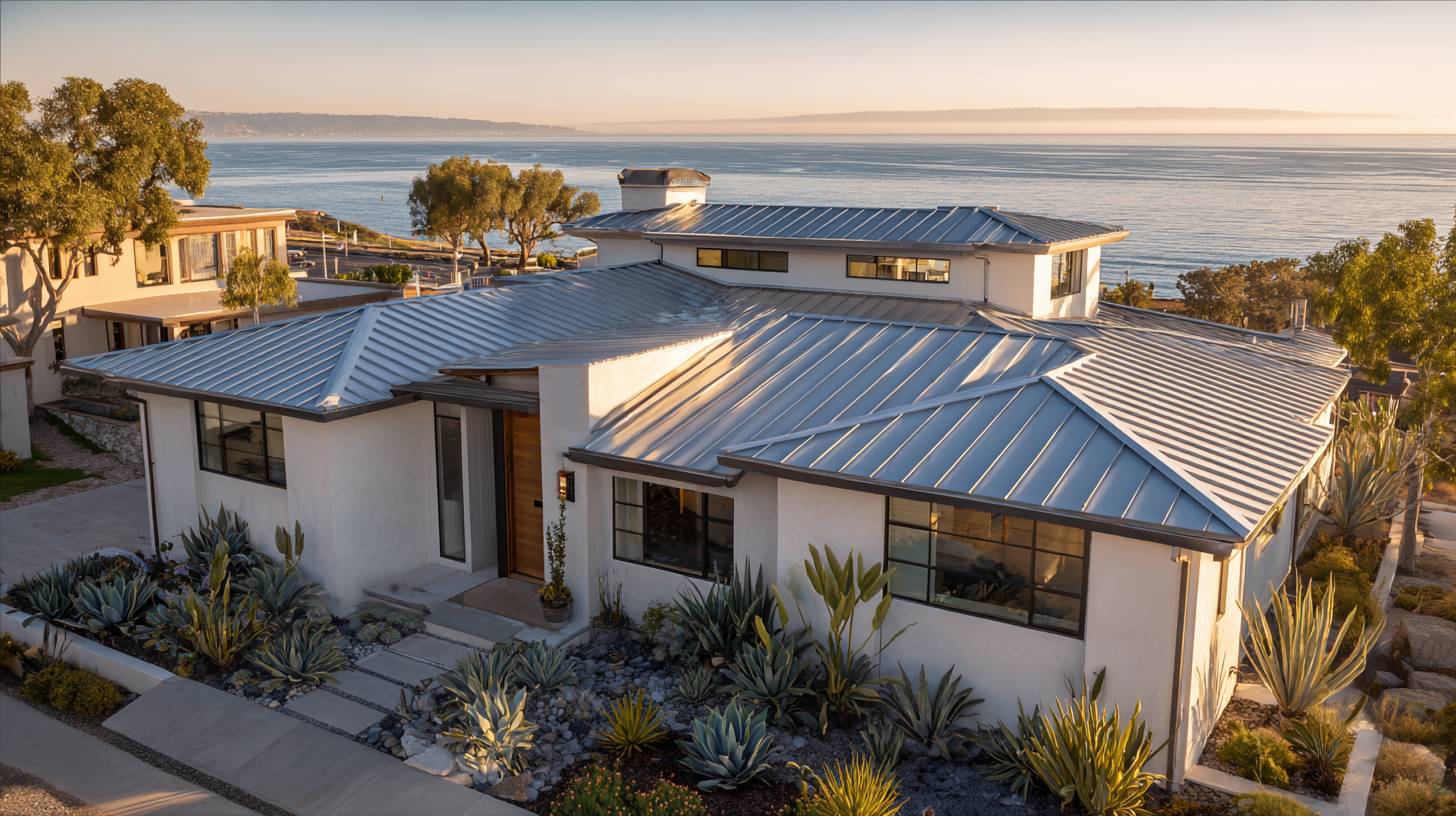Table of Contents [hide]
If you’re researching metal roofing San Diego, you want clear answers on price, code compliance, and which metal roofing systems actually perform in our coastal and inland climate. This guide shows you what to look for—materials, energy efficiency, and assemblies that stand up to salt air and Santa Ana winds—so you can choose with confidence.
Below, you’ll see how local climate zones affect cool-roof rules, why Class A fire-rated assemblies matter near the Wildland–Urban Interface, and how installation details separate a long-lasting metal roof from a noisy, leaky one.
At a Glance (Cost • Materials • Climate Tips)
2025 San Diego metal roofing costs:
- Corrugated/through-fastened steel panels: $9–$14/sq ft; add $1.50–$3.00/sq ft for tear-off/disposal when needed.
- Standing seam (painted steel, PVDF): $16–$24/sq ft (clips, concealed fasteners, high-temp underlayment). Steep/complex roofs typically add +10–25%.
- Standing seam (aluminum for marine/coastal): $18–$28/sq ft (marine-grade accessories, stainless fasteners).
- Metal shingles/metal tiles (stone-coated or formed panels): $12–$20/sq ft, depending on profile and fastening method.
Best-fit by the owner’s needs: Use Standing Seam for most inland/coastal homes; metal shingles/metal tiles where HOAs prefer shake/tile looks; Corrugated Metal Roofing for ADUs/outbuildings and tighter budgets. Pick cool-color metal roof finishes for energy efficiency and comfort; where required by the Energy Code, choose CRRC-rated products.
💡 Quick climate tips: Confirm your CEC climate zone and follow steep-slope cool-roof thresholds (aged solar reflectance, thermal emittance, or SRI) to reduce roof temperatures and peak cooling demand, especially inland.
Cost Landscape & Scope Assumptions
Localize line items with the RSMeans City Cost Index and note labor trends from BLS OEWS; then document assumptions (one- vs. two-story, tear-off/disposal, deck repairs, penetrations). This yields apples-to-apples ranges you can validate with multiple bids.
Scope tiers you’ll see on quotes:
- Repair/Retrofit over a sound deck.
- Full Replacement with tear-off, high-temperature underlayment, flashings, and proper disposal.
Depending on where you’re from, coastal adders (aluminum/PVDF finishes, stainless hardware), baseline inland-valley pricing, and mountain/desert travel or WUI detailing differ per state. Metro vs. suburban/rural labor can vary with access and staging.
Codes, Climate Zones & Energy Efficiency
Use the CEC Climate Zone Tool to verify your address. Where steep-slope cool-roof rules apply, the Energy Code references aged solar reflectance (SR), thermal emittance (TE), or SRI; products must be CRRC-rated for compliance. Cool roofs cut heat gain and improve comfort, especially inland.
In WUI areas, roofs must be Class A assemblies; check the listed products in the State Fire Marshal’s Building Materials Listing.
Best-Fit Metal Roofing Systems & Styles for San Diego
Standing seam metal roofing panels (steel with PVDF or aluminum) deliver clean lines, strong weathering, and easy solar mounting; choose energy-efficient cool colors. Metal shingles/metal tiles mimic slate, shake, or tile with less weight. Corrugated metal panels are economical, so spec the right gauge and fasteners.
Pair systems with local styles (e.g., Ranch, Spanish/Mediterranean, and Contemporary) and consider architectural metals, metal siding, and architectural metal details for curb appeal.
Coastal Corrosion Control (Aluminum vs. Steel)
Within the marine band of San Diego and neighboring Orange County coasts, favor aluminum or AZ-coated steel with PVDF finishes, plus stainless fasteners and compatible sheet metal accessories.
Rinse schedules and avoid dissimilar-metal contact to help longevity; plan emergency sheet metal repairs after storms. Guidance on corrosion-resistant connectors and fasteners comes from FEMA.
Wind & Uplift in Santa Ana Conditions
Ask for systems tested to ASTM E1592 (metal panels) and UL 580/UL 1897 (uplift for roof assemblies/roof coverings). Proper clip spacing, fastener patterns, and edge/ridge zones are critical for standing seam metal roof systems and corrugated sheet metal details.
Installation Essentials, Housing Eras & DIY vs. Pro
Must-haves for residential metal roof installation: high-temperature underlayment, balanced attic ventilation, moisture control, and well-flashed curbs/skylights, each backed by national manuals and best practices.
What you’re likely replacing: older cedar shake, aging asphalt, or heavy tile near end-of-life. Metal’s lighter weight and Class A options suit seismic and WUI realities.
For occupied homes, code compliance, and WUI details, hire licensed pros skilled in sheet metal fabrication, like pan-length limits, hems, thermal movement, instead of doing it yourself. Use market vocabulary when comparing metal roofing styles, metal roofing materials, metal panels, and standing seam metal roofing panels.
FAQs
Do I need a permit and inspections?
Yes. Re-roof projects typically require permits, and inspectors may verify underlayment, flashing, and product labels for Energy Code compliance.
How do I know if cool-roof rules apply to me?
Check your climate zone and use CRRC-rated roofing to meet the aged SR/TE/SRI thresholds when required.
Are metal roofs good for wildfire areas?
In WUI zones, pick a Class A roof assembly and ember-resistant details listed by the State Fire Marshal.
What about Santa Ana winds?
Request assemblies with documented ASTM E1592 and UL 580/1897 performance, and follow edge-zone fastening details.
Ready to Start Your Metal Roofing Project?
Compare metal roofing in San Diego services with Mr. Remodel. We can connect you with vetted local installers who understand Title 24/CRRC, WUI Class A, corrosion control, and Santa Ana wind detailing. Ask for side-by-side quotes on Standing Seam, metal shingles, and Corrugated Metal Roofing, plus a solar-ready layout. Request quotes for your project today.





